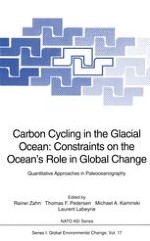1994 | OriginalPaper | Buchkapitel
Paleoproductivity: Flux Proxies Versus Nutrient Proxies and Other Problems Concerning the Quaternary Productivity Record
verfasst von : W. H. Berger, J. C. Herguera, C. B. Lange, R. Schneider
Erschienen in: Carbon Cycling in the Glacial Ocean: Constraints on the Ocean’s Role in Global Change
Verlag: Springer Berlin Heidelberg
Enthalten in: Professional Book Archive
Aktivieren Sie unsere intelligente Suche, um passende Fachinhalte oder Patente zu finden.
Wählen Sie Textabschnitte aus um mit Künstlicher Intelligenz passenden Patente zu finden. powered by
Markieren Sie Textabschnitte, um KI-gestützt weitere passende Inhalte zu finden. powered by
There are three fundamentally different proxies recording ocean productivity in sediments: those representing flux (that is, export production), those representing nutrient concentrations (e.g., nitrate or phosphate), and those representing aspects of the trophic structure of the pelagic environment. Flux proxies disagree due to different power-law relationships to the source term. The particular power-laws (expressed in terms of proxy exponents) change as a function of geography, and may change as a function of time. Modification of the accumulation rate by changing preservation on the sea floor (and within the sediment) is an important aspect of this problem.Combining the use of flux proxies and nutrient proxies makes it possible to estimate the magnitude of physical processes such as mixing and upwelling, and the positive feedback from nutrient buildup in the thermocline. These effects are subsumed into a parameter [v] in the equation Flux = nutrients x [v]. A study of data from the western equatorial Pacific suggests that mixing, upwelling and subsurface nutrient buildup were greatly increased in glacial Stage 6. Diatom abundance does not go parallel to either the flux or the nutrient proxy. Paradoxically, it shows reverse fluctuations. Silicate starvation during glacials may be indicated.
